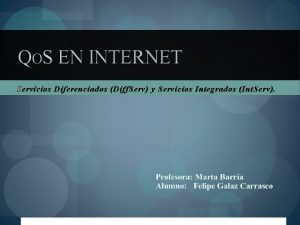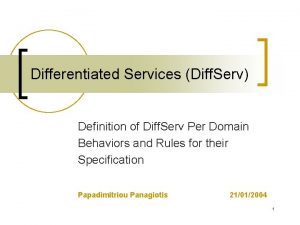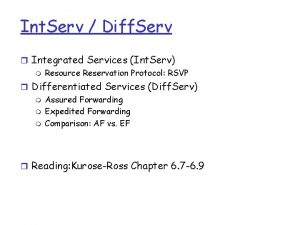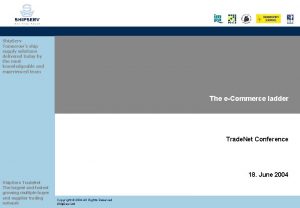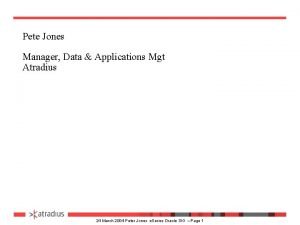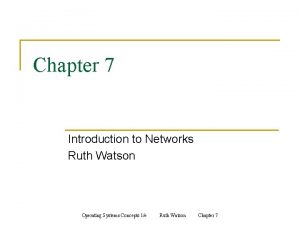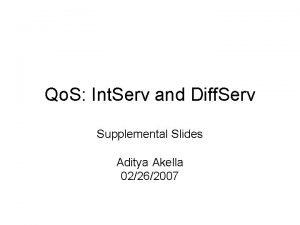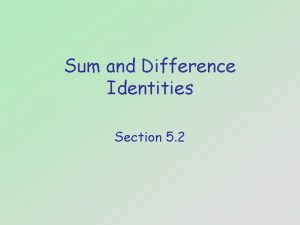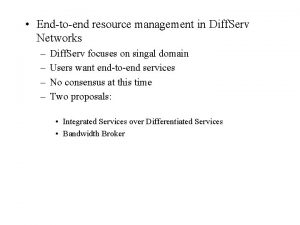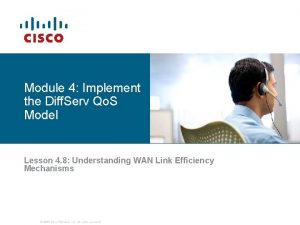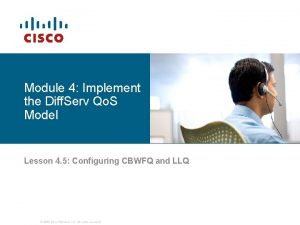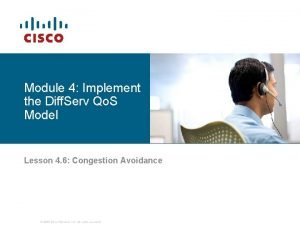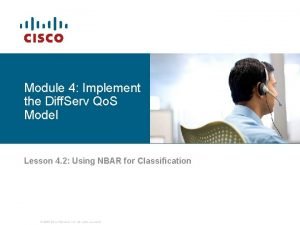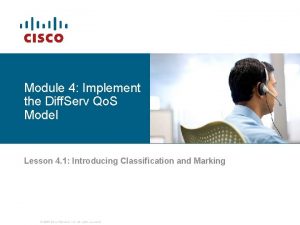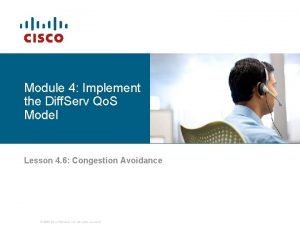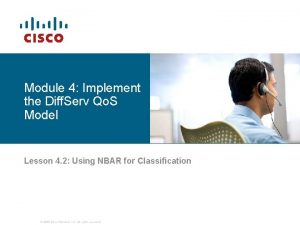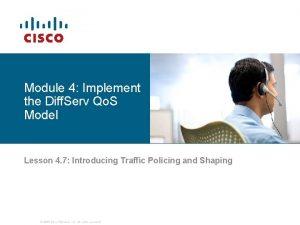Module 4 Implement the Diff Serv Qo S
















- Slides: 16

Module 4: Implement the Diff. Serv Qo. S Model Lesson 4. 9: Implementing Qo. S Preclassify © 2006 Cisco Systems, Inc. All rights reserved.

Objectives § Describe a Virtual Private Network. § List popular VPN protocols and their characteristics. § Explain why a mechanism such as Qo. S Preclassify is necessary when implementing Qo. S with a VPN. § Explain how Qo. S Preclassify is used with GRE and IPsec tunnels. § Describe how to configure Qo. S Preclassify. © 2006 Cisco Systems, Inc. All rights reserved.

Virtual Private Networks § A VPN carries private traffic over a public network using advanced encryption and tunnels to protect: Confidentiality of information Integrity of data Authentication of users § VPN Types: Remote access: Client-initiated Network access server Site-to-site: Intranet Extranet © 2006 Cisco Systems, Inc. All rights reserved.

Encryption Overview © 2006 Cisco Systems, Inc. All rights reserved.

VPN Protocols Protocol L 2 TP Description Standard Based on Cisco Layer 2 Forwarding Layer 2 Tunneling (L 2 F) and Microsoft's Point-to-Point Protocol Tunneling Protocol (PPTP), RFC 3631 GRE Generic Routing Encapsulation RFC 1701, RFC 1702, RFC 2748 IPsec Internet Protocol Security RFC 4301 © 2006 Cisco Systems, Inc. All rights reserved.

Qo. S Preclassify § VPNs are growing in popularity. § The need to classify traffic within a traffic tunnel is also gaining importance. § Qo. S preclassify is a Cisco IOS feature that allows packets to be classified before tunneling and encryption occur. § Preclassification allows traffic flows to be adjusted in congested environments. © 2006 Cisco Systems, Inc. All rights reserved.

Qo. S Preclassify Applications § When packets are encapsulated by tunnel or encryption headers, Qo. S features are unable to examine the original packet headers and correctly classify packets. § Packets traveling across the same tunnel have the same tunnel headers, so the packets are treated identically if the physical interface is congested. © 2006 Cisco Systems, Inc. All rights reserved.

GRE Tunneling § To. S classification of encapsulated packets is based on the tunnel header. § By default, the To. S field of the original packet header is copied to the To. S field of the GRE tunnel header. § GRE tunnels commonly are used to provide dynamic routing resilience over IPsec, adding a second layer of encapsulation. © 2006 Cisco Systems, Inc. All rights reserved.

IPsec AH § IPsec AH is for authentication only and does not perform encryption. § With tunnel mode, the To. S byte value is copied automatically from the original IP header to the tunnel header. § With transport mode, the original header is used, and therefore the To. S byte is accessible. © 2006 Cisco Systems, Inc. All rights reserved.

IPsec ESP § IPsec ESP supports both authentication and encryption. § IPsec ESP consists of an unencrypted header followed by encrypted data and an encrypted trailer. § With tunnel mode, the To. S byte value is copied automatically from the original IP header to the tunnel header. © 2006 Cisco Systems, Inc. All rights reserved.

Qo. S Preclassification Deployment Options § Tunnel interfaces support many of the same Qo. S features as physical interfaces. § In VPN environments, a Qo. S service policy can be applied to the tunnel interface or to the underlying physical interface. § The decision about whether to configure the qos preclassify command depends on which header is used for classification. © 2006 Cisco Systems, Inc. All rights reserved.

Qo. S Preclassification IPsec and GRE Configuration § Qo. S preclassify allows access to the original IP header values. § Qo. S preclassify is not required if classification is based on the original To. S values since the To. S value is copied by default to a new header. IPsec and GRE configuration: ! crypto map static-crypt 1 ipsecisakmp qos pre-classify set peer …. etc ! interface Tunnel 0 etc. . qos pre-classify crypto map static-crypt ! interface Ethernet 0/1 service-policy output minbwtos crypto map static-crypt ! Note: To. S byte copying is done by the tunneling mechanism and NOT by the qos pre-classify command. © 2006 Cisco Systems, Inc. All rights reserved.

Configuring Qo. S Preclassify router(config-if)# qos pre-classify • Enables the Qo. S preclassification feature. • This command is restricted to tunnel interfaces, virtual templates, and crypto maps. GRE Tunnels router(config)# interface tunnel 0 router(config-if)# qos pre-classify IPSec Tunnels router(config)# crypto map secured-partner router(config-crypto-map)# qos pre-classify © 2006 Cisco Systems, Inc. All rights reserved.

Qo. S Preclassify: Example © 2006 Cisco Systems, Inc. All rights reserved.

Self Check 1. What is the Qo. S preclassify feature? 2. What happens with the IP type of service (To. S) values when the packet is encapsulated for transport through a tunnel? 3. In VPN environments, where can the Qo. S service policy be applied? 4. What command is used to enable Qo. S preclassification? © 2006 Cisco Systems, Inc. All rights reserved.

Summary § A virtual private network (VPN) is defined as network connectivity deployed on a shared (public) infrastructure with the same policies and security as a private network. § The Qo. S preclassify feature provides a solution for making Cisco IOS Qo. S services operate in conjunction with tunneling and encryption on an interface. Cisco IOS software can classify packets and apply the appropriate Qo. S service before data is encrypted and tunneled. This allows service providers and enterprises to treat voice, video, and mission-critical traffic with a higher priority across service provider networks while using VPNs for secure transport. © 2006 Cisco Systems, Inc. All rights reserved.
 Servicios integrados ejemplo
Servicios integrados ejemplo Diff serv
Diff serv Diff in diff regression
Diff in diff regression Int serv
Int serv Brutus remote password cracker
Brutus remote password cracker Dtcc 011
Dtcc 011 Ship serv
Ship serv Rekeszizom sérv képek
Rekeszizom sérv képek Atradius serv net
Atradius serv net Apa serv alexandria
Apa serv alexandria C device module module 1
C device module module 1 Find y
Find y What is difference between unix and linux
What is difference between unix and linux Diff of sec^2x
Diff of sec^2x Diff between workgroup and domain
Diff between workgroup and domain Diff
Diff Sum and diff identities
Sum and diff identities
